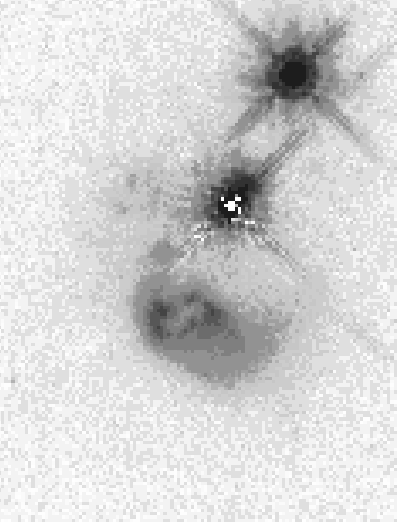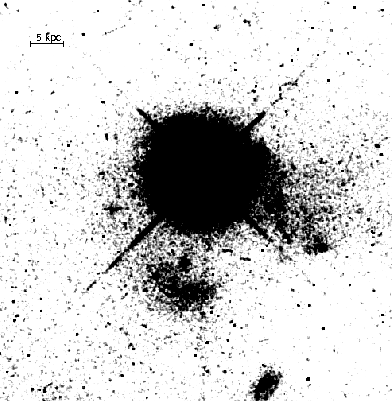 , M.J. Disney
, M.J. Disney ,
J.C. Blades
,
J.C. Blades , A. Boksenberg
, A. Boksenberg , P. Crane
, P. Crane ,
J.M. Deharveng
,
J.M. Deharveng ,
F.D. Macchetto
,
F.D. Macchetto , C.D. Mackay
, C.D. Mackay , and W.B. Sparks
, and W.B. Sparks
|
Документ взят из кэша поисковой машины. Адрес
оригинального документа
: http://www.stsci.edu/stsci/meetings/shst2/boycep.html
Дата изменения: Wed Jun 15 19:38:40 2005 Дата индексирования: Sat Dec 22 10:22:22 2007 Кодировка: Поисковые слова: rho ophiuchi |
P. J. Boyce , M.J. Disney
, M.J. Disney ,
J.C. Blades
,
J.C. Blades , A. Boksenberg
, A. Boksenberg , P. Crane
, P. Crane ,
J.M. Deharveng
,
J.M. Deharveng ,
F.D. Macchetto
,
F.D. Macchetto , C.D. Mackay
, C.D. Mackay , and W.B. Sparks
, and W.B. Sparks
 Department of Physics and Astronomy, University of Wales
College of Cardiff, P.O. Box 913, Cardiff CF2 3YB, UK
Department of Physics and Astronomy, University of Wales
College of Cardiff, P.O. Box 913, Cardiff CF2 3YB, UK
 Space Telescope Science Institute, 3700 San Martin Drive,
Baltimore, MD 21218, USA
Space Telescope Science Institute, 3700 San Martin Drive,
Baltimore, MD 21218, USA
 Royal Greenwich Observatory, Madingley Road, Cambridge, CB3
0EZ, United Kingdom
Royal Greenwich Observatory, Madingley Road, Cambridge, CB3
0EZ, United Kingdom
 European Southern Observatory, Karl Schwarzschild Strasse
2, D--8046 Garching, Germany
European Southern Observatory, Karl Schwarzschild Strasse
2, D--8046 Garching, Germany
 Laboratoire d'Astronomie Spatiale du CNRS, Traverse du
Siphon, Les Trois Lucs, F--13012 Marseille, France
Laboratoire d'Astronomie Spatiale du CNRS, Traverse du
Siphon, Les Trois Lucs, F--13012 Marseille, France
 Institute of Astronomy, Madingley Road, Cambridge CB3 0HA,
United Kingdom
Institute of Astronomy, Madingley Road, Cambridge CB3 0HA,
United Kingdom
Keywords: quasars, active galactic nuclei, galaxy evolution
This is a progress report on a continuing survey of 20 QSO host-galaxies by the FOC IDT team using the PC. Although scattered light makes host analysis difficult it is wholly incorrect to believe (e.g., Hutchings 1995) that the HST is no better than a terrestrial camera for this project. On the contrary: comparison of some of our images with their ground-based counterparts (later) clearly demonstrates the immense superiority of HST for all but the lowest surface brightness features of an image.
We are making a reconnaissance of a fair variety of QSO types, generally with redshifts below 0.5, but all with absolute magnitudes brighter than -23, making them undisputed QSOs (Veron-Cetty & Woltjer 1990). Our first four candidates have been published (Disney et al. 1995, Paper 1), two radio, one optical and one X-ray QSO. All four were found to inhabit luminous elliptical galaxies apparently merging with fainter companions.
By chance the next three objects observed, and reported on here, all
happened to belong to that very rare class of IRAS-selected QSOs.
They were originally identified (Low et al. 1988, Low et al.
1989) as such on the basis of their
warm 25 /60
/60 colors, their stellar images on the P.O.S.S. and the
breadth of their emission lines (>5,000 km
colors, their stellar images on the P.O.S.S. and the
breadth of their emission lines (>5,000 km s
s FWHM).
All happen also to be very luminous IR sources with
L
FWHM).
All happen also to be very luminous IR sources with
L 10
10 L
L . We find that all three appear to be
the result of spectacular collisions between two or more
luminous galaxies, probably spirals originally.
. We find that all three appear to be
the result of spectacular collisions between two or more
luminous galaxies, probably spirals originally.
Figure 1 shows IRAS 04505-2958 taken, like all our images, in a 1-orbit exposure through the F702W filter.

Figure: PC image of IRAS 0450-2958. The displayed frame has
dimensions 6.7
 9.5
9.5 .
The Y-axis has P.A. 329
.
The Y-axis has P.A. 329 relative to North.
relative to North.
The two bright components are 2.1arcsec apart, the upper being a
foreground G star (Low et al. 1989). For comparison the ground-based R-band
image published by Hutchings & Neff (1991) partly merges these two
components and fails to identify the interesting lower-left ring-like
structure altogether. Surely this illustrates the generally superiority of
HST for this project, although the ground-based image does locate what
looks to be a long low surface-brightness merger-plane,
15 to the North, which is undetected with HST. The details
for each object appear in Table 1.
to the North, which is undetected with HST. The details
for each object appear in Table 1.
Figure 2 illustrates IRAS 13218+0552, which has been dubbed ``the reddest known quasar'' (Low et al. 1989), having a (B-K) of 7.2.

Figure: PC image of IRAS 13218+0552. The displayed frame has
dimensions 13.6
 15.9
15.9 .
The Y-axis has P.A. 344
.
The Y-axis has P.A. 344 relative to North.
relative to North.
It appears to have several complex merger plumes, as well as a double nucleus.
Figure 3 is IRAS 07598+6508, an apparently less spectacular
object, possibly because scattered
light from the brighter (m =15.3)
nucleus swamps all of the closer-in features.
=15.3)
nucleus swamps all of the closer-in features.

Figure: PC image of IRAS 07598+6508. The displayed frame has
dimensions 21.3
 21.6
21.6 .
The Y-axis has P.A. 315
.
The Y-axis has P.A. 315 relative to North.
relative to North.
Nevertheless, even here there appear to be clear signs of a collision or interaction.
Since in all three cases the hosts are clearly resolved and irregular we have not used the cross-correlation technique adopted successfully in Paper 1. The numbers in Table 1 have been estimated from the simple subtraction of a stellar PSF to ``remove'' the QSO. The ``stretches'' used in all three figures were chosen to illustrate low surface brightness galaxy features and do not do justice to the brighter QSO nuclei.

Table: Properties of the 3 IRAS QSOs.
(a) Comparing them with published numerical simulations (see e.g., Barnes & Hernquist 1992 and references therein) all three look like mergers in their final stages involving two or more giant galaxies---at least one of which must be a spiral. Since their environments do not appear to contain ellipticals, and ellipticals are rarely if ever isolated, the circumstantial evidence is that the pre-merger galaxies were probably not elliptical.

Figure: Relative spectral energy distribution of
the three IRAS QSOs described here (from Low et al. 1988).
Spectra are displayed in descending order of the ratio of
IR-to-optical luminosity. Tick marks on the vertical scale
indicate decades.
(b) Whereas the objects are very luminous (>10 L
L bolometric), the host galaxies are only
bolometric), the host galaxies are only  L
L . Thus, most of their
luminosity probably comes from dust-shrouded AGNs
with up to 7 magnitudes of visual absorption.
. Thus, most of their
luminosity probably comes from dust-shrouded AGNs
with up to 7 magnitudes of visual absorption.
(c) In their properties they are very similar to the ``Ultraluminous IR Galaxies'' of Sanders et al. (1988) such as Mkn 231 (Armus et al. 1994) and Arp 220, but are 3--5 times further away.
(d) They appear to fit (especially their spectra---see Fig. 4) the evolutionary scenario for QSOs proposed by Sanders et. al. (1988) in which a merger event gives rise to a buried QSO whose luminosity later blows the dust away. In this picture these IRAS QSOs must be young.
(e) Seven out of seven of our HST QSOs and a large proportion of the Bahcall et al. (1994,1995) objects appear to be mergers. Thus, mergers would seem to be a necessary, but not a sufficient, condition to form a QSO, given the very high proportion of apparent mergers we see in the surrounding Wide Field Frames.
(f) The IRAS QSO images appear uncannily like some spiral-spiral merger simulations (Barnes & Hernquist 1992). There are enough plumes and other features to suggest that detailed comparisons might eventually yield useful information on the detailed dynamics and, therefore, the dynamical timescales, energies and evolutionary processes involved.
(g) There is too much variety among the various hosts we have detected to draw, as yet, any statistical conclusions.
(h) Such IR-extreme objects as these are extremely rare (Low et al. 1988) in the IRAS catalogue. Less obscured objects would not be so easy to find in the FIR and yet still be too red and too faint to turn up in the optical. As Webster et al. (1995) have suggested, many obscured QSOs could be missing from catalogues.
(i) We reiterate that scattered light makes this kind of project very difficult. Alas, spherical aberration renders the existing FOC coronograph useless. Although there will be a valuable coronographic facility on NICMOS, we believe that a still higher resolution coronograph should be urgently considered for future refurbishment missions.
Armus, L. et al. 1994, AJ, 108, 76
Bahcall, J.N. et al. (preprint 1995)
Bahcall, J.N., Kirhakos, S. & Schneider, D.F. 1994, ApJ, 435, L11
Barnes, J.E. & Hernquist, L. 1992, ARA&A, 30, 705
Disney, M.J. et al. 1995, Nature, 376, 150
Low, F.J. et al. 1988, ApJ, 327, L41
Low, F.J., Cutri, R.M., Kleinman, S.G., & Huchra, J.P. 1989, ApJ, 340, L1
Hutchings, J.B. 1995, Nature, 376, 118
Hutchings, J.B. 1987, ApJ, 320, 122
Hutchings, J.B. & Neff, S.G. 1991, AJ, 101, 434
Sanders, D.B. et al. 1988, ApJ, 325, 74
Veron-Cetty, M-P. & Woltjer, L. 1990 A&A, 238, 69
Webster, R.L. et al. 1995, Nature, 375, 469